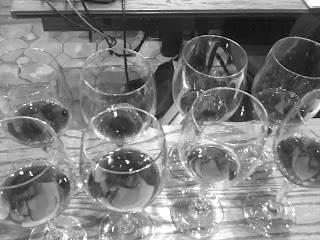The first day I had a variety of reds, whites and a [corked] rose. From the four tastings I have completed, I learned that I don't like very many wines. But there are a few varieties that I would like to have in my house one day like sweet Riesling, Port, Sauvingnon Blanc (from New Zealand) and Gewürztraminer.
Now there is a technique, a professional technique, to tasting wines. Grab a glass and follow along! White wine is my favorite so that will be the example I am using.
Step 1. Hold it against a white background, is it more yellow or green? The more golden a wine the richer the body, and the higher the chance that the wine was aged in oak barrels instead of stainless steel tanks. What's the difference between barrel aged wines and steel aged wine? An oak barrel aged wine will be more robust and richer on the palate.
Step 2. Smell the wine. Does it have an aroma? Swirl the glass and then smell the wine again, I am sure that it smells 100% different now. If it smells like yogurt or dairy products then it is has undergone at least partial malactic fermentation (the conversion of malic acid to lactid acid which results in a creamier, less fruity wine). If it smells like green fruit, odds are the acidity will be high. If it smells like diesel fuel, well you have found yourself a Riesling.
Step 3. After determining everything you can from the wine by smell, its time to taste. Take a sip. Swish it around. Then spit it out. Yes, spit it out, into a Dixie-Cup, or I guess you can swallow it if you would rather.
Step 4. Note all of the flavors. If your mouth is dry then there are a lot of tannins in that wine from either the grape skins (this is true for red wines only) or the wooden barrels. If your mouth is watering as well, then there is a a lot of acid in that wine.
That is just a brief overview of how to taste a wine. There is so much you can learn about a wine before you actually put it in your mouth. My favorite part of wine tasting is finding out how much each one sells for wholesale. So far, as it turns out, my taste in wine is relatively cheap!
I am curious about this, how many people keep boxed wines as opposed to bottled wine in their homes?
Is wine really that popular?
Does anyone really drink it every night?
Let me know!



No comments:
Post a Comment